We will learn more about Venus in this post and some of the impressive statistics that surround this body in our solar system. So if you want to find out the answers to Venus’ orbital period read on.
What Is Venus?
Venus is a rocky planet in our solar system which is the second closest to the sun. It is earth’s closest planetary neighbor and one of the four inner terrestrial planets. The structural similarities between Venus and the earth have often earned it the moniker “Earth’s twin” although there are vast differences between the two rocky planets.
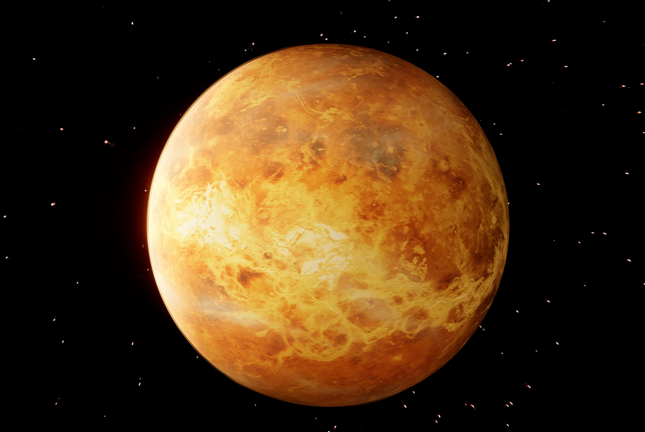
How Far is Venus from Earth?
With the exception of the moon, Venus is the earth’s closest neighbor. It is roughly 61 million kilometers (38 million miles) away. Its proximity to Earth saw the United States and the Soviet Union sending frequent probes to Venus with the trip taking around 4 months.
How Far is Venus from the Sun?
Venus undergoes an elliptical orbit of the Sun meaning that at different times of its year it is at differing distances from the surface of the Sun. It ranges from 66,782,000 miles (107,476,000 km) to 67,693,000 miles (108,942,000 km) away.
Venus’s Structure
Venus’s dense toxic atmosphere is extremely heavy in carbon dioxide and is actually the thickest of all of our solar system’s rocky planets. Covered in dense yellow clouds of sulfuric acid which trap heat Venus is the hottest planet in our solar system. This is due to a very intense greenhouse effect and the close proximity to the sun.
Venus’s diameter is 12,103.6 km (7,520.8 mi) which is only 638.4 km less than Earth’s. Its mass is roughly 81.5% of Earth’s which means in size the two planets are very similar. Its dense atmosphere consists of 96.5% carbon dioxide, with most of the rest being nitrogen.
Venus’s Volcanoes
Much of the surface of Venus appears to have been carved by volcanic activity. It is in fact historically far more volcanic in nature than the Earth and has over 167 volcanoes wider than 100 kms. In excess of 85,000 volcanoes have been mapped on the planet.
The dense clouds of sulfur speak to the volcanic past and changes that have been mapped over the years indicate some level of volcanic activity still exists. It is postulated that the famous Venusian lightning may be connected to volcanic eruptions.
Internal Structure
It is hard to say with certainty what the internal structure of Venus looks like but its similarities to Earth may hint to a similar structure. This suggests the existence of a core, mantle and crust with the core likely being at least partially molten in nature. Although the core having solidified is not impossible.
Another big difference between Venus and Earth is the fact that there appears to be no indication of tectonic movement on Venus. This is possibly due to the crust being too strong and lack of oceans which would serve to soften it. As a result this slows the cooling of the planet and may be a cause of the lack of a magnetic field.
Does Venus Have Moons?
Venus is one of two planets in our solar system that has no natural satellites at all which is something that interests astronomers. There are three main ways that a planet gets a moon and early in the history of our solar system conditions were such that it is odd that Venus did not get at least one.
Prevailing thinking suggests that moons can be “captured” into orbit as they drift by the planet. This is likely what happened to Phobos and Deimos (near Mars). Alternatively an object may have smashed into the planet expelling fragments out beyond the planet’s atmosphere which eventually came together into a moon. Our own Moon is thought to have been created in this manner. Finally the moons might arise from the general accretion of matter. This is how the planets themselves were formed.
History of the Observation of Venus
Visual Observations
Its close proximity to Earth means that Venus has been a feature in our night sky since the two planets were created. Ancient human cultures would be well aware of this bright light in the sky as it would have been the third biggest object visible from Earth behind the Sun and the Moon.
The closeness of Venus however caused an issue which had ancient astronomers confused. It is not a continuous presence in the night sky as its closeness to the sun would cause it to disappear from our view on Earth for days at a time. It would then reappear in a different section of the sky leading to early beliefs that it was not a single entity. It was instead assumed to be two different stars.
Indications suggest that it was the ancient Sumerians who were the first to realize that the two perceived bodies were in fact one celestial object. To the Babylonians Venus was known as Ninsi’anna (divine lady, illumination of heaven).
It was in the second century that Almagest Ptolemy correctly theorized that Mercury and Venus were located between the Sun and Earth. It would take until the 12th century for an Andalusian astronomer Ibn Bajjah to observe two planets as the black spots on the face of the Sun. A century later astronomer Qotb al-Din Shirazi cast doubt on this observation claiming that Venus was not in transit during Ibn Bajjah’s lifetime.
Telescopic Observations
It was Italian physicist Galileo Galilei who first observed the planet Venus through a telescope in the early 17th century. Galileo found that it showed phases much like Earth’s Moon. They would vary from crescent to gibbous to full and vice versa.
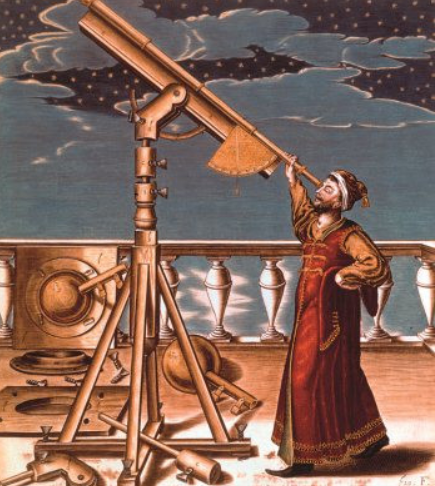
It was observed that when Venus is furthest from the Sun in the sky, it shows up in a half-lit phase. However when it is closest to the Sun in the sky, it instead shows as a crescent or full phase. This could only be the case if Venus orbited the Sun. It was evident from this observation that the Ptolemaic geocentric model that the Solar System was concentric and centered on Earth was wrong.
Space Age Exploration
It was the Soviets in 1961 that made the first attempt to send a probe to Venus in the form of Venera 1. They however lost contact with the probe and the mission was a failure. It would be the United States Mariner 2 mission that would be the first to succeed.
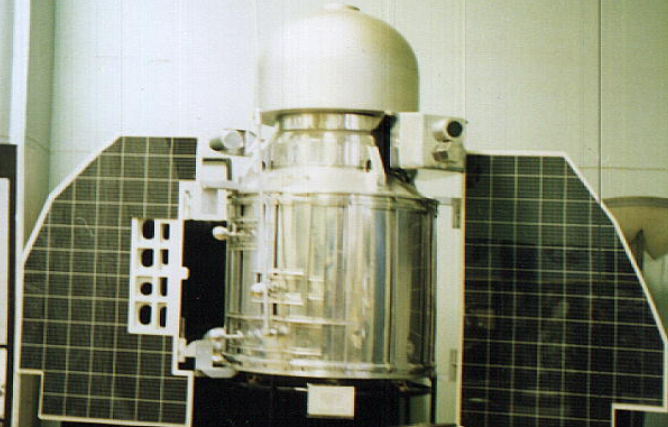
Mariner 2 passed Venus on December 14th 1962 at 34,833 km above the surface gathering data as it traveled. Later in 1966 the Soviet probe Venera 3 became humanity’s first probe to impact another celestial body other than the Moon. Data could not be collected however as the probe had crash landed.
It was Venera 4 however that successfully released science equipment into Venus’s atmosphere leading to the discovery of the surface temperature and the makeup of the atmosphere.
What Is the Sun?
The orb that is visible in our daylight sky which we know as the sun is in fact a star. This star is classified as a yellow dwarf and is central to our solar system. Earth and the other planets of our solar system orbit this vast star. In fact it is our own planet’s rotation and orbit which creates the appearance of the sun moving across our sky. It itself is stationary as we revolve around it.
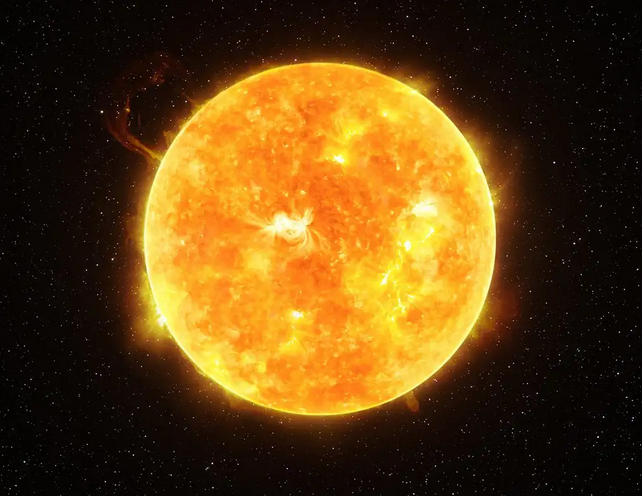
How Big Is the Sun?
The sun on a clear day is visible from the earth and in fact we should never stare directly at it. This is despite it being 93 million miles away so just how big is this giant orange orb? Scientists estimate that the sun has a radius of roughly 435,000 miles.
This may sound massive but there are many known stars which are much larger. In comparison to our planet however the son is roughly 330,000 times the mass of earth and we could fit our planet into the sun 1.3 million times.
What Holds the Sun Together?
The sun because it is a star is actually a huge ball of gas which is held together by its own internal gravitational forces. It is made up of several regions which include in order from the center out:
- Core
- Radioactive zone
- Convection zone
- Photosphere
- Chromosphere
- Transition zone
- Corona
Once material exits the corona of the sun at supersonic speeds, it becomes what is known as a solar wind. This solar wind forms a huge magnetic bubble of sorts around the sun which is known as the heliosphere. It is this heliosphere that extends beyond the orbit of all the planets in our solar system. Essentially our planet as well as all others in the solar system are held within the sun’s atmosphere.
How Long Does Venus Take to Go Around the Sun?
Often referred to as Earth’s Twin, the two planets are not that alike really but they are close neighbors. Venus however is closer to the Sun than our own planet and as a result has a shorter orbital period. It takes Venus roughly 225 Earth days to make an orbit of the Sun. A year on Venus then lasts 225 Earth days, roughly 140 days less than our own planet.
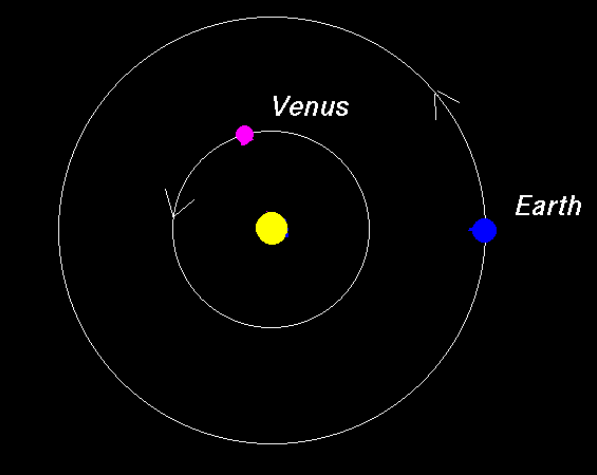
Final Thoughts
Similar in size and composition to our own planet our neighbor Venus sits closer to the Sun than we do on Earth. Because of this from our perspective and the relative closeness of Venus to the Sun the two bodies never seem to stray far from each other when observed.
A Venus year lasts 140 days less than an Earth year with an orbital period of 225 Earth days. Another interesting fact is that Venus itself spins slowly as it orbits the Sun. A single day on Venus lasts 243 Earth days which means it orbits the Sun faster than the planet itself can revolve once on its axis.
